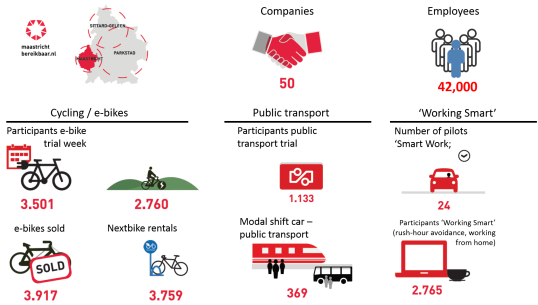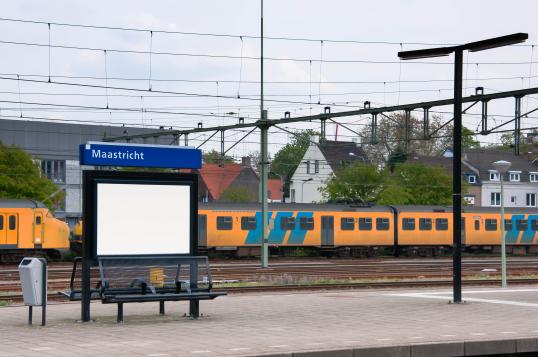- Topic
- Mobility management
- Country
- Netherlands
- Resource type
- Case study
First published on 27 August 2019.
Is it possible to enhance mobility and at the same time improve urban vitality and sustainability in a polycentric region — where many of the smaller centres are just outside the catchment area of the major public transport axes, and where many consider that the distances are too great to cycle?
The Programme Office Maastricht Bereikbaar (Accessible Maastricht) successfully implemented a demand and mobility management programme to reduce congestion and achieve a healthy living and working environment in South Limburg, in the south of the Netherlands. Targeted short-term actions, implemented in close cooperation between public and private sector stakeholders, have been a key part of the success.
Context
From 2012 to 2017, the Programme Office Maastricht Bereikbaar managed the implementation of local and regional demand and mobility management measures, which were part of the national programme Beter Benutten ('Optimising Use'). Initially focussing on the city of Maastricht (which has 122,000 inhabitants), the programme expanded to include first the South Limburg region (home to 600,000 people) and later large parts of the province of South Limburg, which has a population of 1.1 million.
The main objective of the programme was to reduce congestion by 20% and door-to-door journey times by 10% by promoting smarter, more efficient use of transport infrastructure. At the same time, measures were implemented to reduce emissions and help maintain a healthy living and working environment in the region.
In action
To achieve these objectives Maastricht Bereikbaar used a highly targeted approach, focusing on groups with the same travel motive, as well as on specific areas or corridors. The target groups were commuters, students, visitors and logistics service providers. For each of the groups and for the various geographical areas, mobility patterns and travel behaviour were analysed in depth using a variety of sources (e.g. surveys, traffic counters, models, public transport smart card information). Based on the information obtained from this analysis, travellers were offered suitable alternatives to their usual means of transport or time of travel. Alternatives that were promoted included public transport, cycling, electric transport, car sharing, multimodal transport by the provision of all-in-one mobility passes, e-bikes/vehicles, as well as new park-and-ride facilities and urban freight consolidation centres. In addition, projects were carried out to promote off-peak travel and remote working.
Marketing and communication played a key role in promoting the uptake of measures and in stimulating structural changes in the travelling and working behaviour of commuters, visitors, students and lorry drivers. Maastricht Bereikbaar developed a ten-step plan to attract and guide travellers from their first trial experience, during which they could test travel alternatives, to support in acquiring e-bikes, mobility passes and other necessary enablers, and in adopting new travel behaviour (e.g. by the provision of route planning, travel information and incentive schemes). Marketing and communication tools were developed in consultation with behavioural scientists and included financial incentives, the introduction of game elements and an off-peak points saving system, in which commuters could earn points for every off-peak commute. These points could be traded for rewards, such as a donation to charity or, in cases where several employees of the same company were participating, a company outing.
In addition, Maastricht Bereikbaar has been ‘branded’ as the portal for information for everyone interested in mobility management and accessibility. It developed its own visual identity and functions as one clear, unambiguous and recognisable communication channel for all target groups.
Cooperation between local governments, employers and providers of mobility services has been crucial to the success of the programme. Representatives of these parties also make up the supervisory board that oversees the work of the programme office. In the implementation of actions to manage mobility and demand for travel there is a key role for businesses and other employers: during rush hours, the largest group of travellers is, of course, commuters.
An approach focusing on employers was adopted to target commuters more effectively and allow some of these commuters to travel less — or not at peak times, and not by car. So-called ‘mobility brokers’ were used to support and motivate companies to participate in the programme. Mobility brokers helped in the selection, elaboration and implementation of measures that were most suitable for particular companies, tailored to the specific situation of the area and the participating employees.
As a result of the employer-focused approach, a regional network of employers that have participated in the programme has emerged. Through the network, employers learn from each other at network meetings and work together in the field of smart and sustainable mobility. The mobility brokers also act as a link and mediator between the government and the network of companies.
The final pillar of the demand and mobility management programme of Maastricht Bereikbaar was to monitor and evaluate the programme. A comprehensive monitoring and evaluation scheme was set up. This allowed for an evidence-based assessment of the effectiveness of the measures. Information was gathered to assess the detailed steps of the intervention logic of different measures. This helped to create insights into why certain measures worked and why others proved to be less effective. As a result of continuous monitoring it was also possible to adjust measures and increase their effectiveness.
Results
The programme successfully introduced a number of innovative measures to better manage mobility and reduce congestion, with a high participation from the private sector (from employers).
Between 2012 and 2014, some 2,000 commuters participated in one or more measures that aimed to influence their mobility patterns. On average, 50% of the participants witnessed a structural change in their behaviour and started to avoid taking the car during rush hour. By the end of 2014, 26 employers were participating in the programme, which resulted in a reduction of 1,350 car trips per day during the morning rush hour. In the five main corridors targeted by the programme the impact was even higher, with a reduction of 2,200 car trips in the morning rush hour per day. These changes resulted in a reduction of 650 tonnes of CO2 emissions.
By the end of 2017, 50 employers were participating in the programme, which represented a total of 42,000 employees. On average, 3,800 cars trips were avoided during the morning rush hour on a daily basis: the equivalent of a 12 km queue. A large part of these reductions was from commuters shifting from car use to cycling (i.e. bicycle or e-bike). Most of the overall impact (81%) resulted from the employer-focused approach, while 19% resulted from other measures, such as measures targeting urban logistics and visitors to events. In total, Maastricht Bereikbaar reduced CO2 emissions by five million tonnes, the equivalent of the yearly production of 600 households.
Image source: © Jitchanamont/ Shutterstock.com - no permission to re-use image(s) without separate licence from Shutterstock
Challenges, opportunities and transferability
Experiences from Maastricht Bereikbaar have yielded some important lessons for other local authorities that want to take action on demand and mobility management. These lessons include the following points:
1) There is added value in integrated management: the application of this to back office functions, marketing, communication, monitoring and evaluation all helped to increase the effectiveness of the measures, as their implementation could be better coordinated.
2) Adaptive design and implementation increases effectiveness: adjusting the design and implementation of actions based on the results of intermediate evaluations increased the impact and success of the programme. Continuous monitoring and evaluation are therefore very important.
3) Focus on both users and corridors: by identifying key corridors and focussing on specific users of these corridors, there can be a more focused approach in creating and targeting the measures.
4) An employer-focused approach is effective: the combination of products and services offered by Maastricht Bereikbaar and the changes in employers’ policies were particularly effective and resulted in lasting changes in mobility behaviour after approximately three years.
5) Apply behavioural knowledge:
- This contributes to delivering better projects, more motivated participants, greater effectiveness and more structural impact: In projects in which behavioural principles have been applied, the reduction in rush hour traffic is almost twice as high per participant as in projects where this was not done.
- Of the behavioural principles applied, trials and the application of social influence stand out as being particularly successful: projects with trials yield almost twice as much in the way of a reduction in rush hour traffic per participant compared to other projects using other behavioural principles. In projects where social influence was used, the effect is 1.5 times as strong.
- Good preparation is half the battle: the better the understanding is of the behaviour of the target group, the better the chance that the message reaches them. By starting with a thorough target group analysis, the behaviour principles can be better geared to the target group.
6) It is better to target times when there are major road works and tourist events to attract participants to the programme: periods during which there are major road works and tourist events that attract new road users to the areas provide good opportunities to introduce demand and mobility management measures to road users.
In Depth
More information: https://www.maastrichtbereikbaar.nl/en/homepage
Contact: Casper Stelling casper [dot] stelling maastricht-bereikbaar [dot] nl (casper[dot]stelling[at]maastricht-bereikbaar[dot]nl)
maastricht-bereikbaar [dot] nl (casper[dot]stelling[at]maastricht-bereikbaar[dot]nl)


